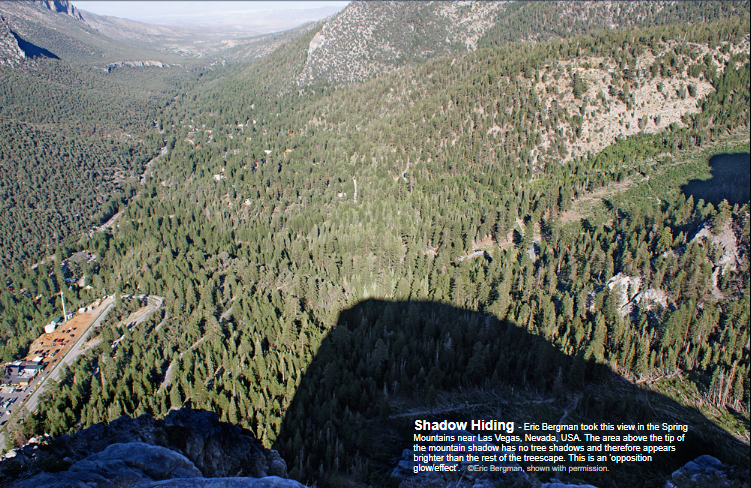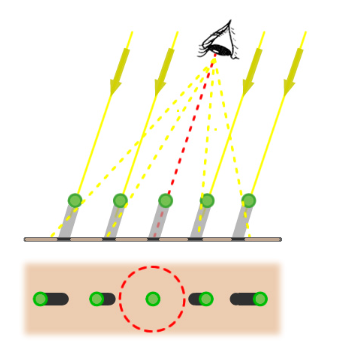Shadow Hiding
Shadow Hiding: An Intriguing Atmospheric Phenomenon
Have you ever noticed a small area in a treescape or a field of stubble that appears brighter and slightly more yellow than its surroundings? This captivating phenomenon is known as the opposition effect or opposition glow. It can be observed when looking downwards at a landscape from a mountain or an airplane, specifically towards the point directly opposite the sun, known as the antisolar point. As you move, the brighter spot seems to accompany you across the landscape, making the subtle contrast differences more apparent.
The opposition effect has several causes, one of which is shadow hiding. At the antisolar point, shadows are hidden beneath the objects that cast them, resulting in fewer visible shadows and a brighter appearance. As you move farther away from the antisolar point, the shadows gradually become more visible, appearing on the side of the object nearest to the antisolar point. This interplay between hidden and visible shadows contributes to the intriguing opposition glow.
One fascinating aspect of the opposition effect is the color variation observed in the antisolar point area. Shadows typically have a bluish hue because they are predominantly lit by the blue sky. However, at the antisolar point, the absence of blue shadows gives way to a more yellow appearance. This contrast in colors adds to the visual allure of this atmospheric phenomenon.
While shadow hiding plays a significant role in creating the opposition effect, it is not the sole contributor. Other factors, such as retroreflection in rock minerals and an effect called coherent backscatter, also contribute to the overall brightness of the antisolar point area. Additionally, if there is dew present, another phenomenon known as heiligenschein further enhances the brightness of this region.
The opposition effect is most easily observed when in motion, as the brighter spot appears to move along with you across the landscape. This movement allows for a better appreciation of the subtle contrast differences that contribute to the opposition glow. Whether you're hiking in the mountains or flying high above the earth, taking a moment to observe and appreciate the shadow hiding and other factors behind the opposition effect can add a touch of wonder to your experience.
In conclusion, shadow hiding is an intriguing component of the opposition effect, a phenomenon that manifests as a brighter and more yellow area at the antisolar point in a landscape. As shadows are hidden beneath the objects casting them, the antisolar point appears brighter due to the absence of visible shadows. This atmospheric phenomenon is further enhanced by the interplay of colors, with the absence of blue shadows contributing to the yellow appearance. While shadow hiding is a significant factor, other elements such as retroreflection, coherent backscatter, and heiligenschein also play a role in creating the opposition glow. Next time you find yourself immersed in a natural landscape, take a moment to observe this captivating phenomenon and appreciate the intricate interplay of light and shadow.

Shadow Hiding - Eric Bergman took this view in the Spring Mountains near Las Vegas, Nevada, USA. The area above the tip of the mountain shadow has no tree shadows and therefore appears brighter than the rest of the treescape. This is an 'opposition glow/effect'. ©Eric Bergman, shown with permission.

Shadows directly opposite the sun (red area) are hidden by the tree or object casting them. The absence of visible shadow makes the area on average brighter.
Look downwards at a treescape from a mountain or airplane. Look towards the point directly opposite the sun, the antisolar point. There is a small area that appears brighter and slightly more yellow than its surroundings. It can also be spotted in fields of stubble.
The effect is most easily seen when you are moving - the brighter spot then moves with you across the landscape and the subtle contrast differences are more apparent.
This is the 'opposition effect' or 'opposition glow'. One.. cause is shadow hiding. At the antisolar point shadows are hidden beneath the objects casting them. Farther away the shadows become less and less hidden. The shadows progressively appear on the side of the object nearest the antisolar point.
The antisolar point area has fewer visible shadows and thus appears brighter. There is another effect. Shadows are bluish because they are lit mostly by blue sky. The absence of blue shadows at the antisolar point renders that area more yellow.
..One cause is shadow hiding. There are others. Retroreflection in rock minerals and an effect called coherent backscatter also contribute. If there is dew then the heiligenschein also brightens the area.
Note: this article has been automatically converted from the old site and may not appear as intended. You can find the original article here.
Reference Atmospheric Optics
If you use any of the definitions, information, or data presented on Atmospheric Optics, please copy the link or reference below to properly credit us as the reference source. Thank you!
-
<a href="https://atoptics.co.uk/blog/shadow-hiding/">Shadow Hiding</a>
-
"Shadow Hiding". Atmospheric Optics. Accessed on December 22, 2024. https://atoptics.co.uk/blog/shadow-hiding/.
-
"Shadow Hiding". Atmospheric Optics, https://atoptics.co.uk/blog/shadow-hiding/. Accessed 22 December, 2024
-
Shadow Hiding. Atmospheric Optics. Retrieved from https://atoptics.co.uk/blog/shadow-hiding/.